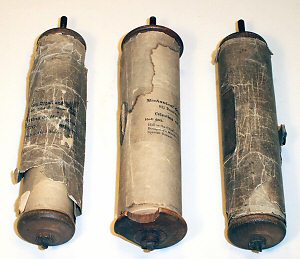
Paper organette rolls were among the first media for the mass distribution of recorded music. Their peak production covered a period of about 20 years, from their mass-marketing in the early 1880s until superseded by the gramophone in the early 1900s. The original rolls have not survived in great numbers, and many of those that have are in poor condition. The illustration opposite shows three typical Celestina rolls in various stages of decay.
Despite their poor condition, these rolls still contain recoverable
music that is an important part of the historical record. The music
covers a broad range of traditional songs, operatic songs and choruses,
popular and music-hall songs, dance tunes, comic songs, religious songs
and hymns, and military songs and marches. The rolls give a snapshot of
the popular culture during the period from the 1850s to the early years
of the 20th century. For example, they tell us that American civil war
songs (from both sides) were still popular well into the 1880s.
In order to preserve (and increase) my supply of organette music, I have been working on several hobby projects which aim to:
The process started early in 1996, when I wrote some computer software to read a MIDI file and print out a template for a 14-note tune sheet. (Yes, it was a nursery rhyme for the baby - but she was nearly six by then). Since that time, I have:
While it has been very rewarding to use computers and modern electronic technology to produce new music for these instruments from the 1880s, it is also rather humbling to realise that the craftsmen who produced the original rolls probably never had the benefit of anything electrical - not even an electric light!